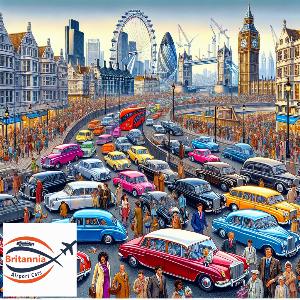Exploring Britains Renaissance Heritage by Minicab

Renaissance Architecture in Britain
Renaissance Architecture in Britain is a testament to the country's rich cultural heritage. This period, spanning the 15th to 17th centuries, saw a revival of ancient Greek and Roman styles, resulting in some of the most iconic structures in the UK. Exploring these architectural marvels by transfer offers a unique and intimate perspective. From the grandeur of Hardwick Hall in Derbyshire to the intricate designs of Longleat House in Wiltshire, each structure tells a story of the era's artistic and intellectual reawakening. The transfer journey allows you to appreciate the detailed facades, symmetrical layouts, and ornate decorations that define Renaissance architecture. The journey also takes you through Britain's picturesque landscapes, adding to the charm of the experience. Whether you're a history enthusiast, architecture lover, or simply a curious traveller, exploring Britain's Renaissance heritage by transfer is an unforgettable journey into the past. This exploration offers a deeper understanding of Britain's history, culture, and the enduring influence of the Renaissance period.
Renaissance Art in Britain
Renaissance Art in Britain is a fascinating chapter in the country's cultural history. This period, spanning the 14th to 17th centuries, saw a significant shift in artistic style and subject matter, reflecting the broader societal changes of the time. British artists began to break away from the religious themes that dominated the medieval period, instead focusing on humanism and naturalism. This shift is evident in the works of prominent British Renaissance artists such as Hans Holbein the Younger and Nicholas Hilliard. Exploring Britain's Renaissance heritage by transfer allows visitors to travel at their own pace, taking in the rich tapestry of art and architecture that this period has left behind. From the grandeur of Hampton Court Palace to the intricate portraits housed in the National Portrait Gallery, a transfer tour offers a unique and intimate perspective on this transformative period in British art history.
Renaissance Literature in Britain
Renaissance literature in Britain, spanning the 16th and early 17th centuries, was a period of profound artistic and intellectual activity that left an indelible mark on the country's cultural heritage. This era saw the rise of iconic figures like William Shakespeare, Christopher Marlowe, and Thomas More, whose works continue to be celebrated worldwide. Exploring Britain's Renaissance heritage by transfer offers a unique opportunity to delve into this fascinating period. Travelling through the streets of London, you can visit the Globe Theatre, where Shakespeare's plays were performed, or the British Library, home to a vast collection of Renaissance texts. A trip to Oxford or Cambridge allows you to walk in the footsteps of Renaissance scholars. Each stop on this literary journey provides a glimpse into the world of Renaissance Britain, bringing to life the stories, ideas, and characters that have shaped our understanding of this pivotal period in history.
Renaissance Music in Britain
Renaissance music in Britain, a period spanning from the 15th to the 17th century, is a rich and fascinating part of the country's cultural heritage. This era saw a significant shift in musical composition and performance, with the introduction of polyphonic music and the use of musical notation. Composers like Thomas Tallis and William Byrd emerged, creating choral works of profound beauty and complexity. As you explore Britain's Renaissance heritage by transfer, consider incorporating visits to historic sites like the Hampton Court Palace, where Henry VIII's court musicians would have performed, or the Tower of London, where Byrd was imprisoned for his Catholic faith. Many churches and cathedrals across the country also host concerts featuring Renaissance music, offering a unique opportunity to experience this historic art form in the settings for which it was originally composed. This journey through Britain's musical past is sure to enrich your understanding of the country's Renaissance heritage.
Renaissance Gardens in Britain
Renaissance Gardens in Britain are a testament to the country's rich historical and cultural heritage. These gardens, dating back to the 15th and 16th centuries, are a reflection of the Renaissance era's emphasis on beauty, symmetry, and harmony. They are characterized by intricate geometric designs, ornate fountains, and an abundance of statues, often inspired by classical mythology. One of the most notable examples is the Kenilworth Castle's Elizabethan Garden, restored to its former glory based on a detailed description from 1575. Another is the Hatfield House Garden, which boasts of a parterre, a knot garden, and a maze. Exploring these gardens by transfer allows visitors to travel back in time and immerse themselves in the grandeur of the Renaissance period. It's a journey through Britain's Renaissance heritage, offering a unique blend of history, art, and nature.
Renaissance Fashion in Britain
The Renaissance period, spanning the 14th to the 17th century, was a time of significant cultural change in Britain, and this was reflected in the fashion of the era. As we explore Britain's Renaissance heritage by transfer, we delve into the world of elaborate clothing that signified wealth and status. The fashion was characterized by opulence, with garments made from luxurious fabrics like velvet, silk, and fur. Men wore doublets and hose, while women donned gowns with tight bodices and full skirts. The use of accessories such as ruffs, hats, and jewellery was also prevalent. The clothing was often adorned with intricate embroidery and lace, showcasing the craftsmanship of the time. The Renaissance fashion in Britain was not just about clothing, but a reflection of the societal changes and the evolving tastes of the British people. As we journey through Britain's Renaissance heritage, we get a glimpse of this fascinating era through its unique fashion.
Renaissance Food and Drink in Britain
During the Renaissance period in Britain, food and drink were integral parts of social and cultural life. The diet was largely based on bread, cheese, and ale, with meat and fish consumed on special occasions. The wealthy indulged in exotic spices, sugar, and wine, showcasing their affluence. The Renaissance saw the introduction of new foods from the New World, such as potatoes and tomatoes, which gradually became staples in British cuisine. Alehouses and taverns were popular social hubs, where people gathered to drink, eat, and converse. The Renaissance also witnessed the emergence of cookbooks, reflecting the growing interest in culinary arts. Exploring Britain's Renaissance heritage through its food and drink offers a unique perspective into the era's social dynamics, cultural exchanges, and culinary evolution. So, hop on a transfer and embark on a gastronomic journey through time, tasting the flavours of the Renaissance and immersing yourself in Britain's rich historical tapestry.
Renaissance Theatre in Britain
The Renaissance period in Britain, spanning from the late 15th to early 17th century, was a time of significant cultural transformation, particularly in the realm of theatre. This era gave birth to some of the world's most renowned playwrights, including William Shakespeare and Christopher Marlowe. The theatre of this period was characterized by its grandeur, with elaborate costumes, intricate set designs, and dramatic performances. The Globe Theatre, a notable example, was a hub of Renaissance drama, where many of Shakespeare's plays were first performed. Today, visitors can explore Britain's Renaissance heritage by transfer, visiting these historic sites and experiencing the magic of the era. From the reconstructed Globe Theatre in London to the birthplace of Shakespeare in Stratford-upon-Avon, these journeys offer a fascinating insight into the world of Renaissance theatre. This exploration is not just a trip, but a voyage back in time, immersing oneself in the rich tapestry of Britain's cultural history.
Renaissance Education in Britain
During the Renaissance period in Britain, education underwent a significant transformation. This era, spanning from the 14th to the 17th century, saw a shift from religious to secular learning, with a renewed focus on the classics. The Renaissance education system was primarily designed for the elite, with grammar schools and universities offering courses in Latin, Greek, theology, and philosophy. The curriculum was heavily influenced by humanist ideals, emphasizing the development of individual potential and critical thinking. This period also witnessed the establishment of several prestigious educational institutions, including Eton College and King's College, Cambridge. As you explore Britain's Renaissance heritage by transfer, these historical schools offer a fascinating insight into the educational practices of the time. They stand as a testament to the period's intellectual fervor and the beginnings of modern education. The Renaissance education in Britain indeed laid the groundwork for the country's current educational system, making it an essential part of the nation's rich cultural heritage.
Renaissance Religion in Britain
The Renaissance period in Britain, spanning from the 14th to the 17th century, was a time of significant religious transformation. This era saw the break from the Catholic Church and the establishment of the Church of England under Henry VIII, a pivotal event in British history. This shift was not just political but also cultural, influencing art, literature, and philosophy. Churches and cathedrals became canvases for Renaissance artists, showcasing the fusion of religious and humanist ideas. The religious turmoil also led to the translation of the Bible into English, making it accessible to the common people and fostering a sense of national identity. Exploring Britain's Renaissance heritage by transfer allows visitors to delve into this fascinating period at their own pace. From the majestic Canterbury Cathedral to the humble birthplace of William Tyndale, the translator of the Bible, each site offers a unique glimpse into the religious landscape of Renaissance Britain.
Our Latest Blog Posts

Minicab Routes to Britains Most Spectacular Waterfalls
Blog about transfer Routes to Britains Most Spectacular Waterfalls
Read More
Nature Escapes: Scenic Minicab Routes to the UKs National Parks
Blog about Nature Escapes: Scenic transfer Routes to the UKs National Parks
Read More
Minicab Journeys Through Britains Ancient Forests and Royal Hunting Grounds
Blog about transfer Journeys Through Britains Ancient Forests and Royal Hunting Grounds
Read More
Minicab Through Time: Visiting Britains Most Historic Towns and Cities
Blog about transfer Through Time: Visiting Britains Most Historic Towns and Cities
Read More
Minicab Adventures in the Footsteps of British Royalty
Blog about transfer Adventures in the Footsteps of British Royalty
Read More
Minicab Rides Along Britains Great Rivers and Waterways
Blog about transfer Rides Along Britains Great Rivers and Waterways
Read More
From London Airports to Britains Iconic Music Festivals by Minicab
Blog about From London Airports to Britains Iconic Music Festivals by transfer
Read More
Minicab Tours of Britains Ancient Celtic and Druid Sites
Blog about transfer Tours of Britains Ancient Celtic and Druid Sites
Read More
Minicab Routes Through Britains Historic Canal Towns and Waterways
Blog about transfer Routes Through Britains Historic Canal Towns and Waterways
Read More
Exploring Britains Industrial Heartland by Minicab
Blog about Exploring Britains Industrial Heartland by transfer
Read More
Exploring the Diversity of Britains Urban Landscapes by Minicab
Blog about Exploring the Diversity of Britains Urban Landscapes by transfer
Read More
British Folklore and Legends: A Minicab Tour of Mythical Sites
Blog about British Folklore and Legends: A transfer Tour of Mythical Sites
Read More
Cultural Capitals: Minicab Adventures from London to Edinburgh and Cardiff
Blog about Cultural Capitals: transfer Adventures from London to Edinburgh and Cardiff
Read More
A Minicab Journey to Britains Most Iconic Sporting Arenas
Blog about A transfer Journey to Britains Most Iconic Sporting Arenas
Read More
A Minicab Guide to the Best of British Theatre and Performing Arts
Blog about A transfer Guide to the Best of British Theatre and Performing Arts
Read More
Minicab Tours to Britains Legendary King Arthur Sites and Camelot Legends
Blog about transfer Tours to Britains Legendary King Arthur Sites and Camelot Legends
Read MoreBlogs Pages
Minicab Journeys to the Heart of Celtic Culture in Wales and Scotland

Blog about transfer Journeys to the Heart of Celtic Culture in Wales and Scotland...
Read MoreMinicab Trips to Britains Renowned Cheese-Making Regions

Blog about transfer Trips to Britains Renowned Cheese-Making Regions...
Read MoreArt and Culture Minicab Tours: From London Airports to Galleries

Blog about Art and Culture transfer Tours: From London Airports to Galleries...
Read MoreMinicab Tours to Britains Historic Fortresses and Castles

Blog about transfer Tours to Britains Historic Fortresses and Castles...
Read MoreHistoric Battlefields by Minicab: A Journey Through Time

Blog about Historic Battlefields by transfer: A Journey Through Time...
Read MoreMinicab Journeys Through Britains Picturesque Countryside

Blog about transfer Journeys Through Britains Picturesque Countryside...
Read MoreMinicab Adventures to Britains Secret Gardens and Hidden Green Spaces

Blog about transfer Adventures to Britains Secret Gardens and Hidden Green Spaces...
Read MoreMinicab Rides Through Britains Literary Landscapes: From Brontë to Dickens

Blog about transfer Rides Through Britains Literary Landscapes: From Brontë to Dickens...
Read MoreA Minicab Trip to Britains Enchanting Fairytale Castles

Blog about A transfer Trip to Britains Enchanting Fairytale Castles...
Read MoreMinicab Tours of Britains Heritage Coastlines and Natural Reserves

Blog about transfer Tours of Britains Heritage Coastlines and Natural Reserves...
Read More
